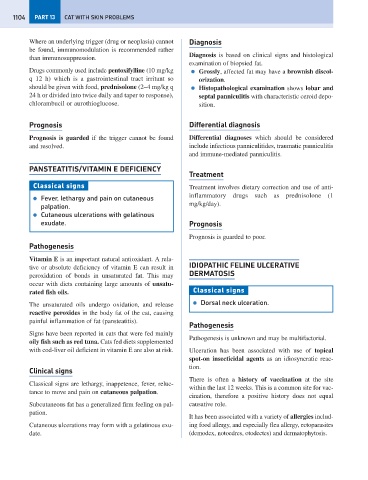Page 1112 - Problem-Based Feline Medicine
P. 1112
1104 PART 13 CAT WITH SKIN PROBLEMS
Where an underlying trigger (drug or neoplasia) cannot Diagnosis
be found, immunomodulation is recommended rather
Diagnosis is based on clinical signs and histological
than immunosuppression.
examination of biopsied fat.
Drugs commonly used include pentoxifylline (10 mg/kg ● Grossly, affected fat may have a brownish discol-
q 12 h) which is a gastrointestinal tract irritant so orization.
should be given with food, prednisolone (2–4 mg/kg q ● Histopathological examination shows lobar and
24 h or divided into twice daily and taper to response), septal panniculitis with characteristic ceroid depo-
chlorambucil or aurothioglucose. sition.
Prognosis Differential diagnosis
Prognosis is guarded if the trigger cannot be found Differential diagnoses which should be considered
and resolved. include infectious panniculitides, traumatic panniculitis
and immune-mediated panniculitis.
PANSTEATITIS/VITAMIN E DEFICIENCY
Treatment
Classical signs Treatment involves dietary correction and use of anti-
inflammatory drugs such as prednisolone (1
● Fever, lethargy and pain on cutaneous
mg/kg/day).
palpation.
● Cutaneous ulcerations with gelatinous
exudate. Prognosis
Prognosis is guarded to poor.
Pathogenesis
Vitamin E is an important natural antioxidant. A rela-
tive or absolute deficiency of vitamin E can result in IDIOPATHIC FELINE ULCERATIVE
peroxidation of bonds in unsaturated fat. This may DERMATOSIS
occur with diets containing large amounts of unsatu-
rated fish oils. Classical signs
The unsaturated oils undergo oxidation, and release ● Dorsal neck ulceration.
reactive peroxides in the body fat of the cat, causing
painful inflammation of fat (pansteatitis).
Pathogenesis
Signs have been reported in cats that were fed mainly
Pathogenesis is unknown and may be multifactorial.
oily fish such as red tuna. Cats fed diets supplemented
with cod-liver oil deficient in vitamin E are also at risk. Ulceration has been associated with use of topical
spot-on insecticidal agents as an idiosyncratic reac-
tion.
Clinical signs
There is often a history of vaccination at the site
Classical signs are lethargy, inappetence, fever, reluc-
within the last 12 weeks. This is a common site for vac-
tance to move and pain on cutaneous palpation.
cination, therefore a positive history does not equal
Subcutaneous fat has a generalized firm feeling on pal- causative role.
pation.
It has been associated with a variety of allergies includ-
Cutaneous ulcerations may form with a gelatinous exu- ing food allergy, and especially flea allergy, ectoparasites
date. (demodex, notoedres, otodectes) and dermatophytosis.

